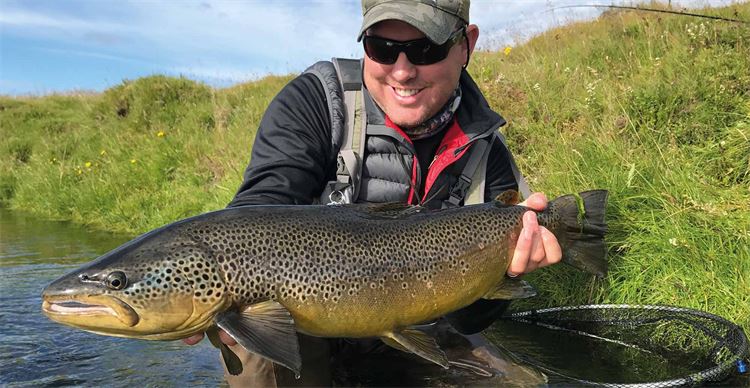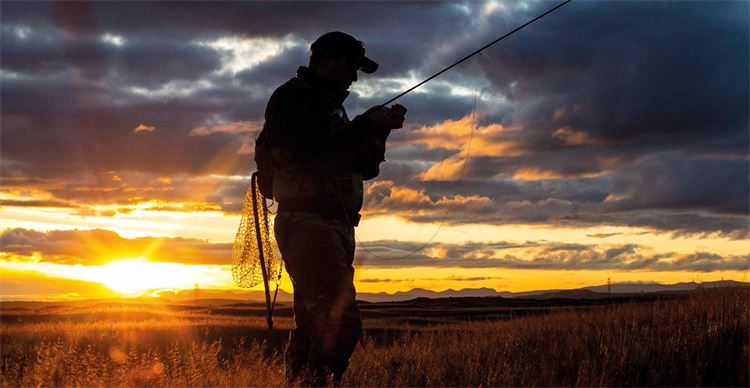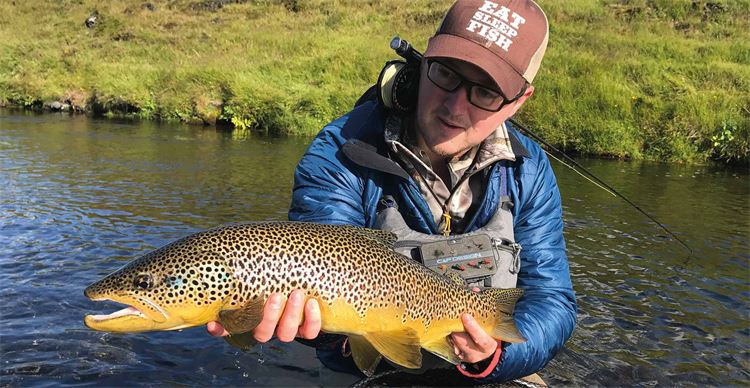The Minnivallalaekur (abbreviated to Minni for those that lack the linguistic skills to combat the rest) is an enchanting and captivating river in the south of Iceland – a mere 90-minute drive from the airport in Keflavik, meandering at the foothills of Mount Hekla and surrounding glaciers. It is a stone’s throw from the revered Ranga rivers, but it is not salmon that makes the Minni famous. Anglers travel from all over the world to target its brown trout – not surprising when you learn that the trout average around 4lb with leviathans into double figures landed every season, and that they are mostly caught on dry fly.
I had been teased by the Minni several years ago. During a fleeting visit, I got to watch and photograph a small group of anglers fishing the river. They knew the river and her moods well and certainly gave me plenty to salivate over as they picked away at the fish in every pool, tempting and landing some spectacular trout. But it was mere flirtation, as I never got to wet a line on the hallowed waters – a bit like visiting a supercar showroom but then being told not to touch...
Having witnessed the calibre of the bounty the Minni had to offer, I vowed to return one day to challenge myself against these Icelandic treasures. Make no mistake, a challenge they are. Trout do not get big by being stupid. Yes, they need to feed to keep their condition and to see them through the long and harsh winter, but this does not mean they become complacent. They will continue to feed as long as you have approached them stealthily, but they will totally ignore any offering that appears alien or that is presented poorly – composure that only comes with age and experience.

The Icelandic summers are short-lived, meaning that the trout need to gorge when food is plentiful. Their feeding window each season is very brief, equating to slow growth rates; large specimens are typically relatively old. Such rivers do not sustain a lot of large fish, they simply cannot due to the simple rules of supply and demand. Indeed, a natural equilibrium is met within the system whereby many of the smaller trout end up as prey to their larger brethren.
These larger specimens are a fragile resource. If any are removed, a void is instantly created that takes many years to recover. Until a few seasons ago, such saddening voids were being created all too frequently. Local anglers would fish the river in the spring when the ice and snow first begins to thaw and the trout are ravenous following their winter hibernation. The water is a lot higher at this time and the trout are certainly less selective. Sinking lines with large streamers were used to devastating effect, with the trophy fish landed being retained for the table.
Thankfully, due to the foresight of the Icelandic lease holder Throstur Ellidason, this has now become confined to the callous past. The Minni is now a strict catch and release fishery and has been for some five seasons or so. As a result, it is once again beginning to thrive. However, as with most big fish rivers, do not expect a river full of fish and ‘a dozen fish’ days. Think more in terms of New Zealand, where you have to walk and work between pools with a lot of dead water between specimens. It certainly feels more like hunting than fishing. You must identify your quarry and then slowly get yourself into a position that affords the best chance possible of taking the shot.
Without doubt this is often best achieved and savoured with a companion. Accompanying me on the trip was my good friend Dan Gazzard, who needed little introduction to such fishing situations. We were unguided, so the first day or so was spent finding our feet but also working out and unlocking the system for the days ahead. Some early mistakes were made and learnt from, none more important than the distance from which the fish were spotting us if we appeared on the skyline. Any skyline presence soon sent the trout scurrying for cover. With just one or two fish in each pool, it was a painful thing to witness and a sour pill to swallow. Furthermore, you could not begin your approach too far away from the fish, as that led to smaller fish being spooked and ‘dominoing’ into the target, causing alarm and sending it heading for cover, too.

We were left with little choice, and had to crawl on hands and knees, or sometimes in a snake-like fashion, to get into a suitable position without disclosing our presence. If this was achieved, which it frequently was following the first day’s failures, then there was every chance of tempting the prize. Long leaders were essential to success, as were delicacy and presentation. Thankfully, light leaders were not a key component to success. In fact, the trout have an amazing set of dentures that will make short work of light tippets, and the riverbed is laden with rafts of weed and also some jagged rocks. The minimum tippet weight we used was 5lb (0.18mm diameter), with heavier materials not hindering efforts.
It would be easy to assume that specimen fish get big within a short feeding window by eating big food items, but this is seldom the case in Iceland. The predominant food item is the midge – the non-biting type, I hasten to add. The midge hatch is prolific with the supply being a constant conveyer belt for the fish. There is often a wind that channels and concentrates the food for the fish, creating clusters of midge that offer sizeable meals. The trout will, however, gladly pick off single offerings, too, as they can be intercepted with little effort.
The Minni trout are most certainly opportunistic – they cannot afford to be too picky. If they are locked onto a prolific midge hatch then seldom will anything else tempt them, but when very little is hatching, the trout will gladly move for a sporadic sedge, stonefly or terrestrial. At such times, searching and speculating with a single generic dry is definitely worthwhile; during the main summer period of mid-July through to mid-August there is a lot of weed, which makes fishing anything but a dry fly virtually impossible.
Fish as long a leader as you can comfortably and confidently control. The longer the leader, the more stealth you will achieve but also the easier it becomes to control drag – both of which will help you put more fish in the net. Fish a tapered leader to help combat the wind – 12–15ft being an ideal length. Beyond that you should attach your tippet material, the length of which will be governed by the conditions – the less wind, the longer the tippet you can control. At the very least, attach 3ft of tippet, with 5ft being commonplace on calmer days.

The fly need not be specific. Foam beetle or spider patterns work well, as do CDC and foam sedge or stonefly patterns. Blacks and browns are usually the extent of the spectrum, so there is little reason to stray from these base colours. The flies can, however, be difficult to track, especially when they enter foam lanes, are fished close to the bank or when a ripple is present. As such, a marker of some description becomes essential – a fluorescent wool post is ideal, but do not use white as that will blend in with the foam, too.
Identify foam lines and you have also identified the feeding lane. When foam gets converged into a single line flowing downriver, the current has manifested this. The trout will actively search for such lines as they act as a trap for insects. It is also worth speculating close to the bank, especially if an undercut appears next to a deep pocket, which will invariably hold a fish.
If a midge hatch is just starting or petering out, the same fly will usually work. However, when the hatch thickens and begins to carpet the water, the trout become transfixed. You may try the larger, generic pattern, of course, but rarely will it provoke a reaction. Stop, watch and observe the trout. Their feeding interval will have a rhythm to it and you will also probably notice them targeting the emerging midge rather than the adult form; an object ‘in’ the water’s surface is far easier to intercept than one ‘on’ the surface.
The midges are small but, thankfully, not miniscule. A size 16–18 will often do the trick, but it’s worth carrying smaller versions for the pernickety customers. It does seem odd to connect such a small hook to heavier tippet material, but do not be tempted to change as this will cost you. The fish are looking for – as is often the case with trout in general – something of the correct size and shape rather than an exact pattern, paying little attention to what connects you to the pattern.

It is essential to treat your leader and tippet correctly. Mucilin – a thick, silicone-based floatant that is applied to the last few feet of your fly line, then the entire length of your tapered leader – is a good place to start. It keeps your line and leader floating high, and helps prevent it being pulled under and causing your fly to act erratically. It also aids control, as your line can be manipulated with ease, given that it has little purchase on the water’s surface. Mud/sinkant is applied to your tippet section. This is not to sink your leader, per se, but rather to remove shine and reflection, enhancing your presentation and masking your presence.
Dan and I fished the river methodically, picking trout from most pools as we worked our way through the system. There are miles upon miles to cover. In fact, there is only one lodge for the entire system, with angling activity limited to just four Rods a day from the source right through to confluence – with a gigantic glacial river named the Thjorsa (the longest river in Iceland) at the lowest extremity. There is a decent track that runs alongside most of the river, which is perfectly navigable with a 4WD vehicle, but the river is better dissected into beats and explored systematically on foot, so to reduce disturbance.
The Minni is a perfect river to fish with a friend on a ‘fish-for-fish’ basis rather than both fishing at the same time. You can learn a lot by watching your fellow angler, but you can also help guide your companion onto a fish that may have eluded them after entering the water and becoming disorientated with its whereabouts.
The river is not about numbers; go with the mindset of quality over quantity. A realistic expectation is two fish per Rod per day. Some days you may not find a fish – especially if it’s windy or particularly cold – but then the following day may bring fair weather and the fish feeding in earnest once more, with a red letter day unfolding as a result. It is always worth conserving your energy for such days, running errands, researching water etc. when the conditions are not so favourable.
We managed several fish in the 55–65cm bracket during our stay, with Dan landing the biggest at 67cm (certainly over 7lb given the girth of the fish) – quite an achievement on a light rod. And we spotted much bigger fish during our stay which sadly eluded us. This does, however, give us a reason to return, and return we will…
www.aardvarkmcleod.com